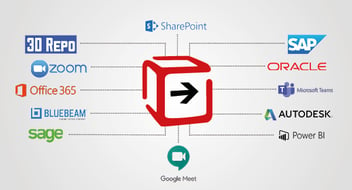
Are you using one type of software for contract management? Another for project financials? And yet another for document management?
Construction management software continues to be developed at lightning speed. This includes everything from digital collaborative contracts to documenting snags in a few taps on your tablet.

With the new year fast approaching, you may need a better way to manage project data and information. A stronger construction management solution can improve life for all—whether on the jobsite or back in the office.
 You’re Going to Need a Connected Solution
You’re Going to Need a Connected Solution
At its most basic level, construction management software can digitally convert and replicate paper-based forms like RFIs, submittals, change orders, site photos, and punch lists. It can bring a new level of visibility to budgets, schedules, and reports.
Recording, tracking, and managing all project details becomes even easier when you step up to a construction management platform solution.
This idea of bringing the industry onto one platform is supported by McKinsey, who predicts we have entered the “platform era.” This involves moving from point solutions to integrated solutions. This means moving away from using different point solutions for CRM, HR, ERP, accounting, takeoff and estimating, bid management, document management, and scheduling,
In its 2023 report, Deloitte notes the need for engineering and construction companies to use digital technologies to “expand business opportunities and boost profits by reducing costs in the long run and enhancing project execution.” With so much pressure on the industry from skyrocketing material costs, labor issues, and competition, they note: “the need for digital transformation in construction has become much stronger.”
Are you future-ready? Are you prepared to handle the vast amount of project data and information generated by every project you tackle in 2023?

5 Signs You Need to Upgrade Your Software
The benefits of construction management software include enhanced collaboration, visibility, and accountability. You may be looking to improve your document management, task scheduling, compliance, or budget tracking.
Is your current construction management software holding you back from reaching your goals? Is it costing you money in the long run?
The first rule is you should be able to configure and customize specific business requirements for any given project or customer. For example, with Asite, your project teams can work seamlessly anywhere with full online capabilities. Dashboards can be configured for an organization or individual user level to ensure transparency and extensibility. You'll get the best of both worlds—configurability and control.
Whether upgrading or considering all new software in 2023, here are five signs it may be time to upgrade your software. Also, let’s look at what features you need when evaluating new construction management tools for your business:
1. Your Dashboards are Limited and CannedYou need dashboards you can customize. When looking at new software, you’ll want to take advantage of reporting capabilities. Make sure you choose a tool with customizable dashboards so you can configure your dashboards to work the way you work.
Instead of generic, canned dashboards, you want dashboards that can be configured for an organization or individual user level to ensure transparency and extensibility. You get the best of both worlds with customizable dashboards—configurability and control. As a result, everyone using your software can aggregate, analyze, visualize, and share data to make better data-driven decisions.
2. You Spend too Much Time on Inflexible WorkflowsIf your construction management software is only good for document review and approval, you're missing out. When you add a tool that allows you to configure complex workflows, you can move beyond linear workflows to assign team members tasks and set due dates.
This means you can create unlimited internal workflows to suit every project need. What about a tool with branching and logic so you can assign tasks to users and define upload triggers? Applying smart and intelligent logic can be a game-changer when it comes to improving the efficiency of day-to-day tasks. Make sure the software you choose allows you to set triggers in your workflows to assign actions and reduce manual errors.
3. You Can’t View and Markup FilesYou don’t want to be stuck with just PDFs that you can’t mark-up or comment on. Nobody wants to lose mark-ups and comments because of limited integration with other file formats. It is much more efficient if you can collaborate on various document file types without needing a license for that application.
Most importantly, this feature will allow you to minimize risk during project planning—when you see other team members’ mark-ups, you can prevent cost overruns and ordering the wrong materials.
4. Your Search and Folder Structure is BasicRelying solely on metadata to find project information can be limiting. Your construction management software should allow you to search across all your projects. Customizing your folder structure means you can manage files and documents your way. File accessibility puts you in the driver’s seat.
5. You can't customize business requirementsConsider whether the software can be customized to meet your business needs—especially when compliance is a consideration. Suppose you’re required to meet government rules, security standards, or corporate and regulatory policies. In that case, you’ll want to choose software with built-in compliance features, such as complying with the global standards ISO 19650 or other security standards.
Using an ISO 19650-compliant software platform will ensure all the stakeholders and project teams can work together more seamlessly across the project.
 Leave Siloed Ways Behind
Leave Siloed Ways Behind
If you choose wisely, the new software will bring all your construction project data and information together in one secure system. You will no longer suffer from cobbling together data and information from several sources.
The end result? Your stakeholders will have access to project information within a centralized location. With a single source of truth, you’ll make more informed decisions, reduce risk, increase collaboration, and avoid duplication. More importantly, you’ll no longer have to worry about team members referencing outdated information or struggling to sort through multiple versions of the same document.
Want to learn more? Join Asite's Solution Engineering team as they walk through the configurable Asite Platform. See how Asite simplifies managing your project information and getting the right information to the right people at the right time to keep your projects on track. Learn more now.
Alexandra Sakhel
Alexandra Sakhel is a Field Marketing Specialist in North America at Asite.
4 minute read
Asite Insights in your inbox.
Sign up for product news and our latest insights published monthly. It's a newsletter so hot, even global warming can't keep up.



